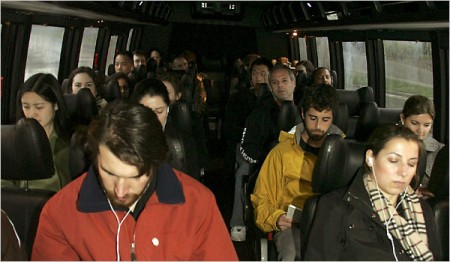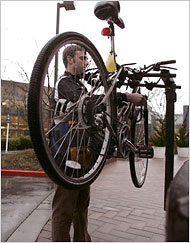From the Internet giant to a small transport company.
 Additional bonuses for Google employees are the envy of people living in Silicon Valley. Unlimited free food, climbing wall, volleyball court and swimming pools. Car wash, oil change in the car and a hairdresser, not to mention a free medical examination.
Additional bonuses for Google employees are the envy of people living in Silicon Valley. Unlimited free food, climbing wall, volleyball court and swimming pools. Car wash, oil change in the car and a hairdresser, not to mention a free medical examination.But the main bonus is the morning drive to work. Silicon Valley Highways is one of the busiest roads in the whole country, and Google is turning from a search engine and an online advertising expert into a passenger transport company. Google’s goal is to keep employees from worrying about how to get to work - which also serves as an additional incentive for new talented engineers who are looking for a place to work - among many other offers on this very competitive job market.

')
Do not forget about a pair of overtime hours that Google employees can devote to work - about the time that otherwise they would have spent behind the wheel of their car. Currently, the company transports about 1,200 people every day to and from work - about a quarter of all local workers, on 32 buses with comfortable leather seats and wireless Internet access. You can attach your bike to the trunk outside the bus, and you can also carry dogs in it - in the next seat or on your lap when the bus is full.
 If the bus is delayed, passengers are notified of this on their computer or cell phone. They can also easily join the Green Party - not only because they drive less on their cars, but also because all buses run on biodiesel.
If the bus is delayed, passengers are notified of this on their computer or cell phone. They can also easily join the Green Party - not only because they drive less on their cars, but also because all buses run on biodiesel.“In essence, this is a small municipal transportation company,” says Marty Lev, head of the company's security department, who oversees the program.
Actually, not so “small”: buses, each of which can accommodate up to 37 people, and on which there are no company identification marks, can be constantly seen on local highways. Every day they make 132 trips, with 40 stops in more than a dozen cities. They cross the borders of six districts in the San Francisco Bay Area, for a total of about 7,000 km.
They pick up passengers, starting from Concord, located 87 km north-east of Googleplex, as the company's headquarters on Mountain View are called, to the city of Santa Cruz, 61 km south. Bus routes pass through 370 km of highways, which is more than twice the length of San Francisco metro routes (167 km).
The morning bus shift starts at 5:05 am - sometimes transporting Google cooks, with the last bus at 10:40. Evening shift is open from 15:40 to 22:05. During the busiest hours, buses leave every 15 minutes.
At the company's office, a small team of specialists builds a model of traffic in the region, notes on the map where new employees live, and creates new routes - sometimes 10 new routes in 3 months - to meet the needs of employees.
“I don’t know about similar programs in this region or other major cities in the country that there would be more of this program,” says Tad Widby, project manager for the 511 Regional Rideshare Program, which is good familiar with the transportation system of the country.
Whether it is a gesture of generosity or concern for the environment, the transportation program is a good weapon in the war of recruiting new employees in Silicon Valley. One of the most difficult tasks that Google faces, with its staff doubling every year, is to continue to attract the best specialists. Many people working in the field of information technology, say that the benefits of stock options for new employees are not so obvious, due to the fact that the company's shares have quadrupled in price since their initial listing on the stock exchange in 2004 year, at $ 85 per share.
“This is the most useful bonus Google offers,” said Wiltse Carpenter, a 45-year-old programmer. He has been with the company for only a few months, but before that, since 1992, he had been driving from San Francisco on the 101st highway every morning, working for Silicon Graphics and Microsoft, two Google neighbors. “It made my life a lot easier,” he says.
And this is not surprising. Even company employees are worried about real estate prices in the area, which is why many families have moved to the far borders of the region, in search of cheaper housing. A vibrant cultural and social life in San Francisco remains attractive to young people, despite the fact that the 56 km road to the company's office takes more than an hour. A recent survey showed that road congestion is the number one problem for local residents, and for the tenth year in a row.
 But on a rainy winter evening, for Google’s 20 employees taking the five-hour bus to the Mission and Noe Valley areas of San Francisco, these concerns seem distant. Their bus leaves on 101 highway, passes through three lanes, filled with slow-moving cars, on a strip for public transport and drives on, leaving behind hundreds of cars with those who get to the house on their own.
But on a rainy winter evening, for Google’s 20 employees taking the five-hour bus to the Mission and Noe Valley areas of San Francisco, these concerns seem distant. Their bus leaves on 101 highway, passes through three lanes, filled with slow-moving cars, on a strip for public transport and drives on, leaving behind hundreds of cars with those who get to the house on their own.Bus passengers have their own rules of etiquette. Talking on a mobile phone is allowed if they are quiet and related to work. Loud personal calls are completely excluded. Apart from families traveling together, no one sits next to another person. Many hold their iPods or laptops in their hands and work, go online, or watch videos. “People want peace and respect from others when they rest after work,” said Diana Alberghini, a 33-year-old program manager.
Google does not discuss the cost of this program, carried out in conjunction with "Bauer`s Limousine", a private transportation company in San Francisco. But buses definitely produce the desired effect on likely new employees. Michael Gaiman, a 23-year-old web application programmer living in San Francisco, says that before accepting an invitation to work from Google, he declined an offer from Apple. “Undoubtedly, this played a role,” said Michael regarding the bus program.
Colin Klingman, 38, who works for a company under a private contract — and pays a small amount for this program to comply with tax rules — says he didn’t send his resume to Google until a bus stop appeared near his house.
And you can see how similar programs are launched by other companies in Silicon Valley. In Yahoo, the main rival of Google, such a program began operating in 2005. On particularly busy days, buses carry around 350 employees from San Francisco and back, as well as to Berkeley, Oakland, and cities on the east side of the bay. Yahoo's buses also run on biodiesel and are equipped with Internet access, but Danielle Bricker, program coordinator, says that Google’s example influenced it only “indirectly”.
Recently, a pilot program started by eBay - it launched a five-stop bus to San Francisco. Other companies are trying different approaches. Instead of making life easier for those who live far from their jobs, Facebook offers a cash allowance of $ 600 to those who live within one mile of the company's headquarters in Palo Alto.
And it seems that Google buses are affecting, albeit slightly, the housing market in the region. So, when Adam Klein, a 24-year-old programmer, moved to San Francisco in 2005 to work for a company, he was looking for an apartment that would be located within 15 minutes walk to the bus stop. Many of his friends also move closer to the stops. “They attract people,” he says. In 2005, a little more than ten employees of the company lived on one site located around the bus stop. Now their number has exceeded 60 people.
Despite the popularity of the program, Google still has to compete for the title of employer, which is the easiest to reach. In the first place in this list, compiled by the Environmental Protection Agency, is Intel, which, among other bonuses, allows you to work remotely, offers cash allowances for travel and pays buses that take workers from transit stops. Google is in third place with Oracle. On the second - Microsoft.
But Google staff, for whom these bus trips are so convenient, says that nothing will outweigh their advantages. “They can take money from us for food, or even stop feeding us at all,” says Bent Hagemark, a 44-year-old programmer, who sits on a bus at Cow Hollow, a prestigious northern San Francisco area. "But if they curtail the transportation program, it will be a real disaster."
Techme translations
Source: https://habr.com/ru/post/30926/
All Articles